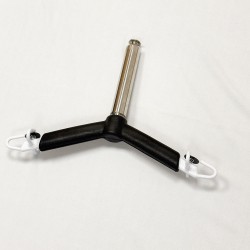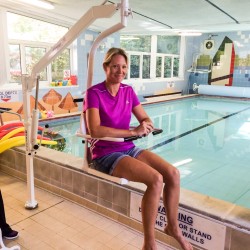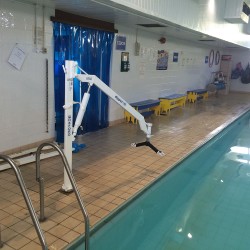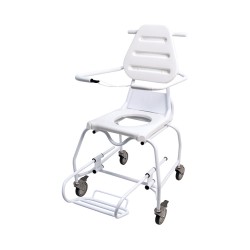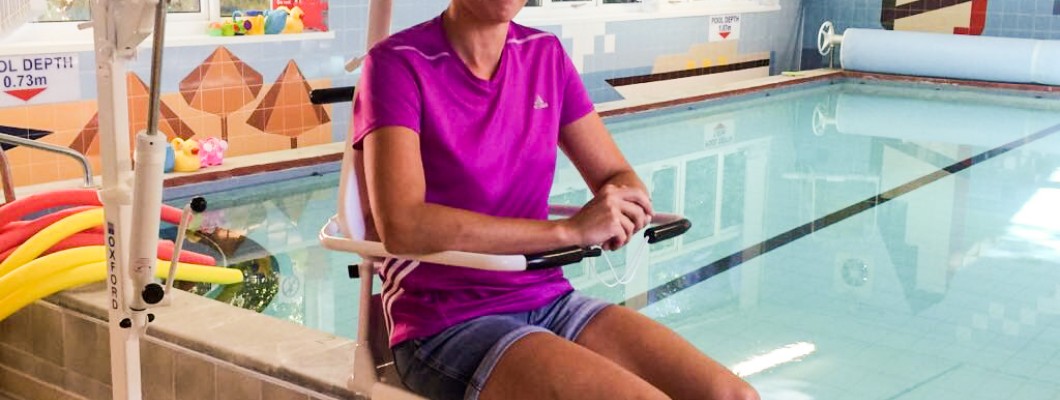
Why is the Oxford Dipper Pool Hoist the best lift for people with a disability?
The Oxford Dipper Pool hoist is the UK market leader for affordable Pool Lift for Disabled people.
The Oxford Dipper Pool hoist is a hydraulic lift that has two models:
Oxford Dipper Pool hoist with sling access
This pool lift is excellent for giving the disabled person access direct into a swimming pool via a sling, for users who are happy to be lifted in at the pool side. The Dipper uses slings with loops. Most users supply their own slings but we can supply bathing slings as these are the quickest to dry.
Oxford Dipper Pool hoist with easy access via a wheelchair
For those service users that have more complex physical challenges and prefer a more dignified entry to the pool, there is the Oxford Ranger Chair which enables a carer or support worker to prepare a person in the changing rooms.
Once, the service user is ready for the pool, they can be transferred into the Ranger Chair. This will enable the support staff to wheel the service user to the Dipper hoist. The ranger is reversed onto the Dipper boom, this will connect with click as they engage.
The Dipper is then pumped to raise, no matter the weight, the dipper is easy to lift service users up to maximum of 140 Kg, 22.05 Stone or 280 Ibs. Once the service-user has been raised to an appropriate height, the column swings manually to the water front.
Once satisfied the entry point is clear of other swimmers, the support staff can lower the Ranger seat into the pool by unscrewing the pump release screw. The hoist will then gently lower the service user carefully into the water. As the the service user is being lowered, they find it very comfortable compared to a sling. Simply due to the fact its a natural sitting position.
For those users with spasm or balance challenges, there is a harness available. There are seating cushions if required. How is the Oxford Dipper Pool hoist fitted and what are the options?
There are three options available:
Socket A
The Oxford Dipper Socket A is the most popular fitment. Whether it’s a commercial, private pool or a sailing club with jetties, the Socket A is preferred. The socket is flush to the floor, when not in use, there is a cap that’s flush to the floor. Prevent tripping and the toes being stubbed.. ouch! The only challenge with the A socket is it needs to fitted correctly. These are the prerequisites:
1. One meter square of concrete is required.
2. Diamond driller - to ensure a vertical hole is created 90mm wide and 300mm deep
3. Accredited engineer to fit the Dipper pool hoist
Socket B
Socket B is similar to socket A, however this is slightly more complicated as it’s designed for commercial pools which have drainage around the edge. See technical manual for details.
Socket C
The Dipper socket C is designed for fitments to poolsides or quays with no 1 meter sq. concrete. The only challenge with the C socket is it’s fitted on the surface, fitted with concrete bolts. It looks like a pyramid shape.
We can offer a free survey. If you wish to view a dipper, call the office on 01772 814555 and we shall see if we can arrange a visit to an installation near you.
What's the benefit of swimming for disabled people?
These are, the type of disability swimming that you may see on the TV every four years when it comes to the Paralympics, and secondly, the type of disability swimming that I was most familiar with as a child growing up – which was actually more like a form of physiotherapy, but this time in the water… thus being known as hydrotherapy!
For all these two types of disability swimming might be very different, they both offer a wonderful sense of freedom which many disabled individuals would otherwise not get to experience. Once you’re in the water, you’re subject to a type of weightlessness which immediately alleviates pressure on your joints and muscles, and allows you to float and stretch in ways that you might not be able to achieve when out on dry land. It is therefore highly beneficial for severely disabled children and adults, to be able to get out of their wheelchairs and feel the effortlessness that is floating in water.
Alas though, I was never much of a floater myself. No matter how hard I tried I always seemed to end up with my head submerging under the water and I wasn’t much of a fan of that! Thankfully, I seemed to be the only person struggling with it and many of my friends whose disabilities ranged in severity, all enjoyed having the ability to be ‘free’ at long last. We used to swim at least twice a week and it proved to be an integral part in building up core strength for many of us and as our confidence grew, we also branched out and made things slightly more competitive, with games and challenges being interwoven with the important business of hydro-therapy. Which leads me nicely to the next section of disability swimming.
How can disability swimming be competitive?
Well, as I alluded to within my opening paragraph, there’s a lot more to disability swimming than just a bunch of disabled individuals looking to splash around and stretch their bodies in the process. There’s also a competitive side to it, with many people choosing to become professional athletes and representing their respective countries at the Paralympic Games.
You can read the profile of one of the Invacare Ambassadors, Anders Olsson, which is not only a Paralympic Swimmer but is has also represented his country in the Winter Paralympics as a skier.
The Paralympics, as I’m sure you’re aware, is a brilliant sporting event which takes place shortly after the Olympic Games. With that, many of the sports and disciplines that are performed in the Olympic Games are also showcased within the Paralympics, and so, disability swimming is a big part of that set up. There are many disciplines within the disability swimming set up, with varying ranges in race length to different styles of swimming too. It’s also worth noting that each person competing is placed in a race against athletes of a similar handicap, to prevent situations whereby a participant’s disability may impede on his ability to win the race.
As like with many of the disability swimmers Olympic counterparts, swimming has become a way of life for these individuals, and with that, the love for the sport grows, both for those competing and for those spectating right around the world.
Disability swimming is quite a big deal, both to aid those with a disability to give them relief in many senses, and also for those wishing to compete in the sport of swimming. It’s a total splash!

